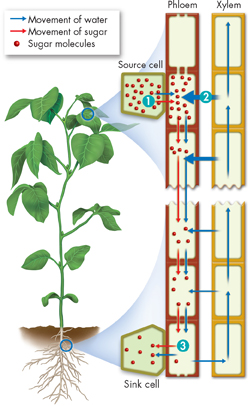Nutrient Transport
 What drives the movement of fluid through phloem tissue in a plant?
What drives the movement of fluid through phloem tissue in a plant?
How do sugars move in the phloem? The leading explanation of phloem transport is known as the pressure-flow hypothesis, shown in Figure 23–21. As you know, unlike the cells that form xylem, the sieve tube cells in phloem remain alive. 1 Active transport moves sugars into the sieve tube from surrounding tissues. 2 Water then follows by osmosis, creating pressure in the tube at the source of the sugars. 3 If another region of the plant has a need for sugars, they are actively pumped out of the tube and into the surrounding tissues. Osmosis then causes water to leave the tube, reducing pressure in the tube at such places. The result is a pressure-driven flow of nutrient-rich fluid from the sources of sugars (source cells) to the places in the plants where sugars are used or stored (sink cells).  Changes in nutrient concentration drive the movement of fluid through phloem tissue in directions that meet the nutritional needs of the plant.
Changes in nutrient concentration drive the movement of fluid through phloem tissue in directions that meet the nutritional needs of the plant.
The pressure-flow system gives plants enormous flexibility in responding to changing seasons. During the growing season, sugars from the leaves are directed into ripening fruits or into roots for storage. As the growing season ends, the plant drops its fruits and stores nutrients in the roots. As spring approaches, chemical signals stimulate phloem cells in the roots to pump sugars back into phloem sap. Then the pressure-flow system raises these sugars into stems and leaves to support rapid growth.

FIGURE 23–21 Pressure-Flow Hypothesis The diagram shows the movement of sugars as explained by the pressure-flow hypothesis. Relate Cause and Effect How does the movement of sugars affect the movement of water?
23.5 Assessment

-
Review What two forces are responsible for 90 percent of the upward flow of water through a plant?
Predict If a plant's stomata close on a hot, dry day, how could this affect the plant's rate of photosynthesis?
-
Review What is the hypothesis that explains the movement of fluid through phloem in a plant?
Compare and Contrast Contrast the roles of active and passive transport in the movement of phloem.
Apply the Big idea
Explain how movement of sugars in the phloem contributes to homeostasis in a plant.

Table of Contents
- Formulas and Equations
- Applying Formulas and Equations
- Mean, Median, and Mode
- Estimation
- Using Measurements in Calculations
- Effects of Measurement Errors
- Accuracy
- Precision
- Comparing Accuracy and Precision
- Significant Figures
- Calculating With Significant Figures
- Scientific Notation
- Calculating With Scientific Notation
- Dimensional Analysis
- Applying Dimensional Analysis




